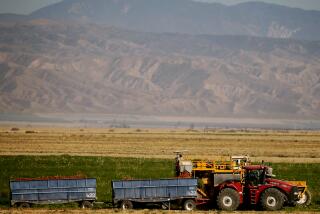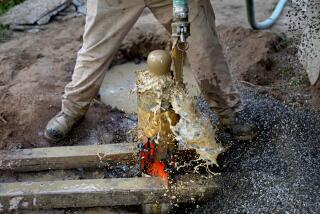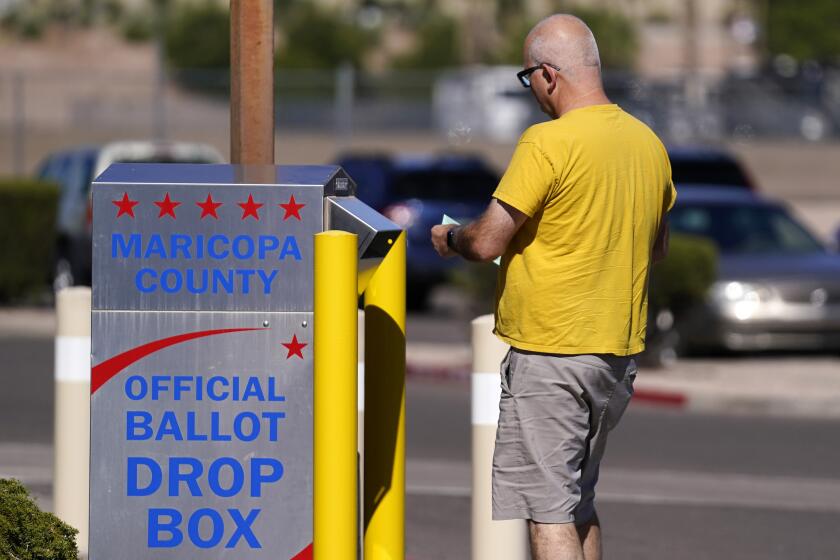Opinion: Does California stand a chance of preserving our precious groundwater?

One of the most consequential environmental laws in state history turned 10 years old last month. You’d be forgiven if you didn’t notice. The Sustainable Groundwater Management Act remains, like the declining resource it aims to protect, largely invisible to most Californians.
Despite this, the first decade of SGMA (“sigma” to those who know it well) has laid the foundation, still somewhat creaky in places, for nothing less than the transformation of our rural landscape and economy. If we allow it to, this law could nurture a genuinely resilient landscape capable of thriving in an era of climate whiplash.
On paper, this is a law solely about managing a finite, limited and largely unseen resource. In implementation, it needs to be about revitalizing the very visible land and communities at the heart of the state.
Ten years ago, California adopted a law to curb chronic overpumping of groundwater. Significant challenges remain, even as the state works toward its goals.
California created an orchard for the world in large part by tapping into prehistoric aquifers that underlay the Central Valley. Much of that water is now gone, never to fully return. By the early 2010s, this long subterranean decline finally became impossible to ignore as drought dried up wells, land sank and canals collapsed. Faced with the deepening scars of groundwater exhaustion, lawmakers passed SGMA — a sweeping road map to get the state to the point at which we’re taking out only as much water as comes in.
A decade on, we still haven’t fully confronted the scale of change required to bring groundwater basins into balance and ensure we have enough water to sustain our farms, ecosystems and rural communities long into the future. Estimates suggest up to 900,000 acres of farmland in the San Joaquin Valley alone might need to be fallowed to reduce the drawdown of groundwater and balance supply and demand. That’s larger than the total area of California’s five largest cities combined — and the San Joaquin Valley is not the only area that will need to take farmland out of production.
If you’ve ever trudged through the dust of a once heavily farmed field abandoned to the sun and wind, you may sense what is in store if we haphazardly take land out of production. The Central Valley would deconstruct into a patchwork dotted with arid, tumbleweed-filled dust zones. In the early days of SGMA, conversations colleagues and I had with growers throughout the valley made it clear groundwater decline was as much a land problem as a water one: We needed a robust transition plan for the hundreds of thousands of acres facing reduced irrigation.
These concerns became the seed for the state’s Multibenefit Land Repurposing Program, a much-needed practical support plan for the transition toward a smaller irrigated footprint. Begun in the summer of 2022, it provides block grants and technical assistance to organizations and tribes for repurposing irrigated agricultural land to uses that reduce reliance on groundwater while providing new community benefits. Including “multibenefit” in the official name for the program is not simply climate wonkishness. There really are layers and layers of unrealized benefits hidden in repurposed farmland.
Towering oaks, converging rivers, vibrant wildlife. You’ll be able to see it all on the 1,600 acres near the confluence of the Tuolumne and San Joaquin rivers.
Take, for example, the rebirth of former farmland at the confluence of the Tuolumne and San Joaquin rivers in the Central Valley, an achievement that predates but should inform California’s land repurposing program. Around 1,600 acres of former agricultural land have been transformed into Dos Rios State Park, a functional floodplain whose long list of beneficiaries, human and otherwise, is steadily growing. Brush rabbits, woodrats, Swainson’s hawks, Central Valley Chinook salmon, steelhead trout, least Bell’s vireos, greater sandhill cranes — all protected species — have found a home on the restored floodplain. A host of migratory birds from the Pacific Flyway are making it a regular stopover.
Land and water are allowed to coexist at Dos Rios in a way that typified much of the Central Valley prior to widespread European settlement. The unconfined space lets the land soak up floodwater, recharging groundwater while also protecting from flooding downstream land, including tribal and socioeconomically disadvantaged communities. In addition, the rewatered floodplain is building up a bank of carbon-sequestering vegetation that also cleans our water supply. It’s a wondrous thicket of benefits that underscores the potential nestled in former farmland across the Central Valley.
The land repurposing program provides funding to support exactly these sorts of projects across the state. Like its sister SGMA, it prioritizes regional and local leadership, giving grants to entities such as Groundwater Sustainability Agencies and tribes who, in turn, work with local groups to develop plans and fund projects. In just two years, the program has been a quiet success, helping nearly 100 organizations working on dozens of projects in regions covering 3.3 million acres.
Yet the current scale of state funding is not equal to the challenge ahead. Lawmakers’ recent approval of a climate bond is a welcome step in the right direction. As voters, we have a chance to approve this critical funding this fall when it appears on the November ballot as Proposition 4. It would include $200 million for land repurposing, $15 million for water data, $610 million for safe and affordable drinking water and $386 million for groundwater programs.
But rural communities will need far more to accomplish what amounts to a reimagining of our life with the land. Through its regional funding structure, the land repurposing program gives farming communities a chance to shape their own transition to a sustainable water future. We need to provide the requisite long-term funding to help them see this transition through.
SGMA has set in motion a shift to a more sustainable future in which agriculture is in balance with long-term water supplies. Ten years on, we need to embrace what this means not just for our relationship with all the water we can’t see, but also for the beautiful, potent land we have the privilege to live with every day.
Ann Hayden is vice president for climate resilient water systems at the Environmental Defense Fund.
More to Read
A cure for the common opinion
Get thought-provoking perspectives with our weekly newsletter.
You may occasionally receive promotional content from the Los Angeles Times.












